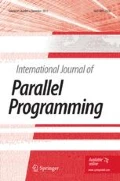Abstract
A commonly used approach for feature selection is to select those features that extremize certain probabilistic distance measures. In most of the procedures it is assumed that the labels of the patterns are perfect. There are many practical situations in which the labels of the patterns are imperfect. This paper examines the applicability of the extremization of the Bhattacharyya distance, the divergence, equivocation, Kalmogrov variational distance, and Matusita distance as criteria for selecting the effective features from imperfectly identified patterns.
Similar content being viewed by others
References
T. Kailath, “Divergence and Bhattacharyya distance measures in signal selection,”IEEE Trans. Commun. Technology COM-15:52–60 (1967).
H. Kobayashi and J. B. Thomas, “Distance measures and related criteria,” inProc. 5th Ann. Allerton Conf. Circuit and System Theory, October 1967, pp. 491–500.
T. Marill and D. M. Green, “On the effectiveness of receptors in recognition systems,”IEEE Trans. Inf. Theory IT-9:11–17 (1963).
T. T. Kadota and L. A. Shepp, “On the best finite set of linear observabies for discriminating two Gaussian signals,”IEEE Trans. Inf. Theory,IT-18:278–284 (1967).
J. T. Tou and R. P. Heydorn, “Some approaches to optimum feature extraction,” inComputer and Information Sciences, Vol. II, J. T. Tou, Ed. (Academic, New York, 1967), pp. 57–89.
K. S. Fu, P. J. Min, and T. J. Li, “Feature selection in pattern recognition,”IEEE Trans. Systems Sci. and Cybernetics SSC-6:33–39 (1970).
A. Caprihan and R. J. P. Defigueiredo, “On the extraction of pattern features from continuous measurements,”IEEE Trans. Systems Sci. and Cybernetics SSC-6:110–115 (1970).
R. L. Kashyap, “Algorithms for pattern classification,” inAdaptive, Learning and Pattern Recognition Systems, J. M. Mendel and K. S. Ku, Eds. (Academic, New York, 1970).
R. O. Duda and R. C. Singleton, “Training a threshold logic unit with imperfectly classified patterns,” Presented at the WESCON Conv. Los Angeles, California, August 1964.
A. W. Whitney and S. J. Dwyer, “Performance and implementation of thek-nearest neighbor decision rule with incorrectly identified samples,” inProc. 4th Ann. Allerton Conf. Circuit and System Theory, 1966, pp. 96–106.
K. Shanmugam and A. M. Breiphol, “An error-correcting procedure for learning with an imperfect teacher,”IEEE Trans. Systems, Man and Cybernetics SMC-1:223–229 (1971).
C. Chitti Babu, “On the extraction of pattern features from imperfectly identified samples,”IEEE Trans. Computers C-21:410–411 (1972).
C. Chitti Babu, “On the application of divergence for the extraction of features from imperfectly labeled patterns,”IEEE Trans. System, Man and Cybernetics SMC-2:290–292 (1972).
G. H. Hardy, J. E. Littlewood, and G. Polya,Inequalities, 2nd ed. (Cambridge Univ. Press, 1952).
F. M. Reza,An Introduction to Information Theory (McGraw-Hill, New York, 1961).
M. E. Hellman and J. Raviv, “Probability of error, equivocation and the Chernoff bound,”IEEE Trans. Information Theory IT-16:368–372 (1970).
A. Feinstein,Foundations of Information Theory (McGraw-Hill, New York, 1958).
C. Chitti Babu, “On feature extraction in pattern recognition,”Proc. 5th Hawaii Int. Conf. on System Sciences, January 1972, pp. 20–23.
B. P. Adhikari and D. D. Joshi, “Distance discrimination et resume exhaustif,”Publ. Inst. Statist. 5:57–74 (1956).
K. Matusita, “A distance and related statistics in multivariate analysis,” inMulti-variate Analysis, P. R. Krishnaiah, Ed. (Academic, New York, 1966), pp. 187–200.
Author information
Authors and Affiliations
Rights and permissions
About this article
Cite this article
Babu, C.C. On the application of probabilistic distance measures for the extraction of features from imperfectly labeled patterns. International Journal of Computer and Information Sciences 2, 103–114 (1973). https://doi.org/10.1007/BF00976057
Received:
Revised:
Issue Date:
DOI: https://doi.org/10.1007/BF00976057




